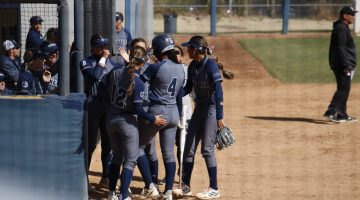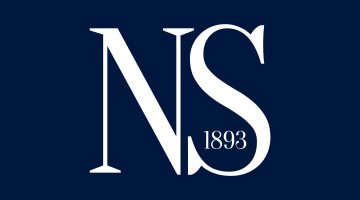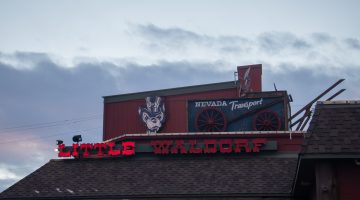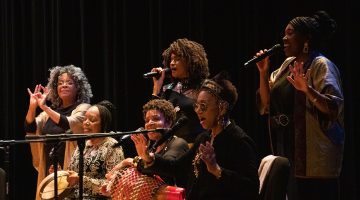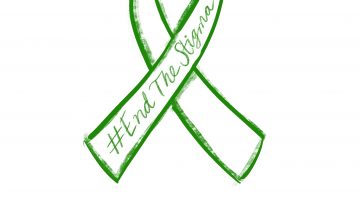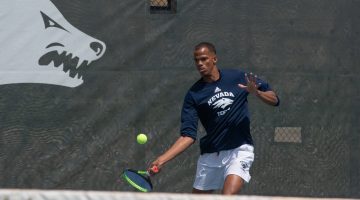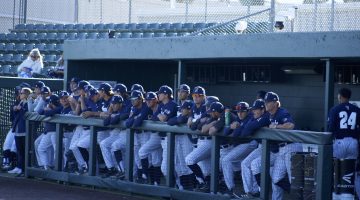
Photo courtesy of Tanner Harvey. The Winter Sports Club has a few members who compete in the Alpine Ski Team. A national championship is held about once a year and the team has won nearly every year since 2011. This is the men’s team at Diamond Peak on Jan. 15.
At the snow-filled mountains, the Winter Sports Club of the University of Nevada, Reno spent time riding down the slopes—skiing, snowboarding and competing. The club has a chance to compete with the Alpine Ski Team and go to Nationals.
The Winter Sports Club is one of the largest student organizations on campus, with about 500 active members. There are two pathways for members: recreational and competing. Recreational members participate for fun, but there is an option to compete on their Alpine Ski Team.
Both skiers and snowboarders can join the club, with their main focus being the big mountains, park riding and shreddin’ the gnar.
Saving big bucks
There are many benefits for club members, whether recreational or competitive, one of them being cost.
The cost to go up to the mountains for the day can be pricey depending on where you go and if you need to rent equipment. The club helps members get a discount on the high costs of skiing and snowboarding.
“The main thing with the club is like skiing and snowboarding is expensive,” said Elsie Childress, social co-chair and senior double majoring in environmental science and range land management. “We try to make it at least a little bit more affordable. So, you know, we get pass discounts.”
The pass sold is the Ikon pass, originally $769, and is distributed by the Alterra Mountain Company. The club is able to get multiple passes for a discount at almost half the cost of the original.
At only $469 through the Ikon College Program, members can obtain the discount as long as they are able to show proof they are an official college club. Close to 300 students used the discount code this school year.
The more passes the club is able to sell, the more free passes they can earn, which are given out during club giveaways. The pass includes 23 mountains–Palisades Tahoe, also known as Squaw Valley Alpine Meadows, and Mammoth. Mount Rose, although close to campus, is too expensive and not included in the pass.
The club starts at the beginning of November, which is when fees are due on a strict deadline. This ensures everyone gets their money’s worth and gets their own individual discount code.
“We also allow, like, if there are students who go to other institutions that don’t have a club, we can get past that, we can give discounts to those students,” Childress said. “Mostly community colleges like [Truckee Meadows Community College] and some of the Cal community colleges.”
There are only a few days in the semester when the entire club plans a day to go shredding, usually on dead day. This year’s plans were canceled due to the lack of snow, but they hope to make it up in late March or April if the weather allows it.
Even with the help of the Ikon College Program, the club struggles with funding for all of the participants.
The club is split between Associated Students of the University of Nevada and Fitness and Recreational Sports. Childress asked for money from ASUN for the Learn to Ski program and all they could offer was $500 when two passes cost $1,100.
“It’s been kind of frustrating just because, you know, Tanner and I just recently, a few weeks ago, had to go to this thing like Title IX training that was about privilege,” Childress said. “It’s like, yes, I know … I’m trying to spread my privilege and use it to provide these free ski days to low income students. But it’s really, really hard. You guys don’t give us money. So it’s like they tell us to be inclusive, but it comes at a cost.”
The Fitness and Recreation Sports has a full-time staff compared to ASUN where majority are student workers. More direct help is also given to the club through donations or fundraising.
Alpine Ski Team and Nationals
For the more serious skiers and snowboarders, members of the club have the opportunity to join the Alpine Ski Team, their competitive branch.
The team competes in alpine racing such as giant slalom and slalom. The athletes can compete in the national championships where there is free ride and alpine races, which is more of a team event.
While practices often happen in the morning, the team makes use of Boreal for their night skiing a few times out of the week.
Since 2011, the team has made it to Nationals every year, except 2013, and when it was canceled due to COVID-19 in 2020.
The men’s team got second place in this year’s conference and the women’s got third. Both teams qualified for Nationals, which are in Lake Placid, New York. This nine-day tournament includes giant slalom, slalom skier cross and dual slalom.
“For national championships, it’s only the top five racers on both men and women team,” said Tanner Harvey, Alpine Co-Chair and third year engineering physics major. “We also have a snowboard Alpine team also, which is usually smaller … I think we only have three snowboarders, two men’s and one women. Only the female made it to Nationals this year.”
Both Harvey and Childress have been to Nationals. This year will be Harveys, second time competing since it was canceled last year.
“The times I went, so my freshman year, we went to Lake Placid and we … the men’s team ended up getting second place and skier cross,” Harvey said. “So that was a good experience to stand up on the podium.”
Anyone can join the team, but it is recommended they are at least an intermediate skier due to the sports dangerous nature, the pass and other things.
There are about 500 athletes who compete at Nationals. There are opening ceremonies, award ceremonies after the events and the closing ceremony. A banquet is also held at the end where everyone dresses up in formal attire for a dinner.
Childress claimed that her experience at Nationals has been atypical, especially in 2019.
“I have gone twice, including the one in 2020,” Childress said. “And then I also went to 2019 champs which were in Jackson, Wyoming … I think just because 2019, like the world, was normal, but I crashed on my first run. And I tore my ACL and had to go home.”
The 2020 Nationals were hectic for the team. The event happened when everything started to get shut down because of the pandemic. UNR called the team and urged them to get an earlier flight, however they could not due to money restraints.
The Winter Sports Club has an Instagram and Facebook page where they give information about the club and do giveaways. Childress believes even though the club is large, it is not an accurate representation of how many students are interested in winter sports.
A variety of students join the club, but what stands out to Childress is the amount of graduate students who participate. One is Zach Minaker who is a Ph.D student in physics. He comes to all of the events, even with his high studies.
“He’s actually been a really, really great, hard working volunteer for ‘Learn to Ski,’” Childress said. “He’s taken multiple students out and taught them how to ski, which is really cool. And the other thing is, he’s like, totally fearless. Like, I’ve got videos of him crashing and you’re like, how could a physics student make that mistake?”
“Learn to Ski” is a program to provide free ski days to low income youth and students. Childress went through 150 applications and randomly selected a certain number the club could afford to pay for and provided them with 17 ski days.
Before 2011, there was an NCAA ski team and not a club due to the Great Recession of 2009. Now that it is a club, they compete at the US Collegiate Ski Association Nationals. The booster organization is still in place for the club as it was before 2011.
Kelsey Middleton can be reached at kelseymiddleton@sagebrush.unr.edu or on Twitter @kelsmiddleunr


